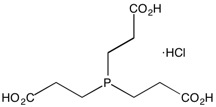TCEP HCl | Reducing agent
NMR (Conforms)

Available Options
| Size : | Price | Quantity | |
|---|---|---|---|
| 1 gram | $35.00 | ||
| 5 gram | $150.00 |
TCEP HCl (51805-45-9) is a reagent for selective reduction of disulfides in aqueous solutions1-3 with distinct advantages over DTT which are application specific3. For example, spin labels are more stable with TCEP than DTT, Ni2+ (leached from affinity columns) causes rapid oxidation of DTT with no effect on TCEP and for long term storage of proteins TCEP is more stable than DTT with no metal chelator (EGTA) present but DTT is more stable in the presence of metal chelators.3
References/Citations:
1) Fischer et al. (1993), In situ reduction suitable for matrix-assisted laser desorption/ionization and liquid secondary ionization using tris(2-carboxyethyl)phosphine; Rapid Commun. Mass Spectrom., 7 225
2) Kirley et al. (1989), Reduction and fluorescent labeling of cyst(e)ine-containing proteins for subsequent structural analysis; Anal. Biochem., 180 231
3) Getz et al. (1999), A comparison between the sulfhydryl reductants tris(2-carboxyethyl)phosphine and dithiothreitol for use in protein biochemistry; Anal. Biochem., 273 73
NMR (Conforms)
Safety Data Sheet:
Product Data Sheet:
Materials provided by Focus Biomolecules are for laboratory research use only and are not intended for human or veterinary applications. Please note that we do not sell to individuals and that all orders placed by non-research organizations will incur a $20 restocking/refund fee
TCEP HCl (51805-45-9) is a reagent for selective reduction of disulfides in aqueous solutions1-3 with distinct advantages over DTT which are application specific3. For example, spin labels are more stable with TCEP than DTT, Ni2+ (leached from affinity columns) causes rapid oxidation of DTT with no effect on TCEP and for long term storage of proteins TCEP is more stable than DTT with no metal chelator (EGTA) present but DTT is more stable in the presence of metal chelators.3
References/Citations:
1) Fischer et al. (1993), In situ reduction suitable for matrix-assisted laser desorption/ionization and liquid secondary ionization using tris(2-carboxyethyl)phosphine; Rapid Commun. Mass Spectrom., 7 225
2) Kirley et al. (1989), Reduction and fluorescent labeling of cyst(e)ine-containing proteins for subsequent structural analysis; Anal. Biochem., 180 231
3) Getz et al. (1999), A comparison between the sulfhydryl reductants tris(2-carboxyethyl)phosphine and dithiothreitol for use in protein biochemistry; Anal. Biochem., 273 73
Calculate the molar concentration, mass or volume in a solution.
Concentration × Volume × Molecular Weight = Mass
Focus Biomolecules • Plymouth Meeting, PA USA • 1-855-FOCUS21
Focus Biomolecules
Plymouth Meeting, PA USA
1-855-FOCUS21
Website Created by Advanta Advertising LLC.

